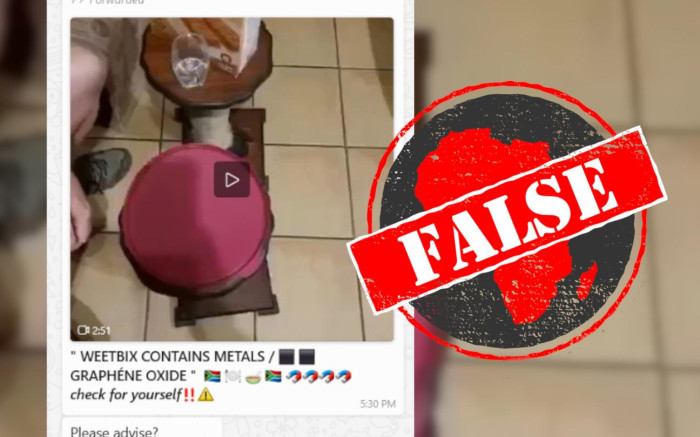
A video recently shared with Africa Check on WhatsApp claims that “our food in South Africa contains graphene oxide”.
While explaining what he’s doing, in Afrikaans, the man in the video finely crushes some Weet-Bix, a popular breakfast cereal, from a previously opened box. He then rolls a magnet in the crushed cereal, causing some of it to stick to the magnet.
He brushes the cereal off the magnet and onto the lid of a plastic container. Finally, he shows that some dark powder moves when the magnet is moved under the lid.
He says this is proof that the cereal contains magnetic graphene oxide – a material that has been the subject of conspiracy theories.
The man claims that “die graphene oxide is die goed wat in die inentings is en so doodelik is vir mense”. This translates to: “This graphene oxide is the stuff that is in the vaccines and is so deadly to people.”
He later says “dis wat in ons kos ingesit word in Suid-Afrika”, which translates as “this is what’s been put into our food in South Africa”.
This video, others similar to it and some posts making the same claim have been shared multiple times on Facebook.
But does the video show that common foods contain graphene oxide?
There is some iron in breakfast cereals
Graphene oxide is a material made up of carbon, oxygen and hydrogen atoms, similar to the super-strong graphene, which is made up of carbon only. First produced in the mid-1800s, graphene oxide became more widely used in the mid-1900s as it became easier and cheaper to produce.
Since then, it has been discovered to have many unique properties, and researchers studying the material have suggested that it has many potential uses in fields such as electronics, optics, and medicine. Because it has been shown to be toxic in some situations, its medical uses are limited.
Magnetic versions of graphene oxide have been made, but that doesn’t mean that every magnetic material is graphene oxide.
One magnetic material found in cereals is iron, a common metal. Iron is added to some foods, including many common cereals, because it is an important nutrient in the human diet. It plays a vital role in the health of the blood, and a lack of iron can cause a blood disorder called anaemia.
Iron can be extracted from cereals in simple home experiments similar to the one shown in the circulating video. One version of the experiment, suggested by the Royal Society of Chemistry as a science classroom exercise, involves placing cereal flakes on the surface of water. A Scientific American article describes a version of the experiment that is almost identical to the process shown in the video of the “graphene oxide” particles in Weet-Bix. These experiments show that magnetic iron particles are present in some common foods.
There is nothing in the videos shared on social media, claiming to extract “graphene oxide” from breakfast cereals, that indicates the substance is anything else but iron. Iron is a very common nutrient and is listed as an ingredient in Weet-Bix and other cereals.
So why is graphene oxide mentioned in this context at all?
Graphene oxide conspiracy theories
Graphene oxide has become a fixation of conspiracy theorists, particularly anti-vaccine conspiracy theorists.
False claims that graphene oxide had been secretly added to vaccines became popular during the Covid-19 pandemic. Many of the videos, in which the man speaking Afrikaans mentions vaccines, were shared in 2021, around the time Covid-19 vaccines became available in South Africa.
These claims have been debunked many many times over by fact-checkers and public health authorities. No reliable evidence of the presence of graphene oxide or other harmful materials in vaccines has ever been produced. Instead, these claims tend to be based on flimsy non-evidence, such as that shown in the circulating video, and often confuse magnetism with other phenomena.
The fear that graphene oxide may have been added to common foods seems to be an offshoot of claims that it was secretly added to vaccines. All of these claims are unfounded.





Recent Comments